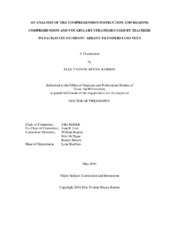| dc.contributor.advisor | Helfeldt, John | |
| dc.contributor.advisor | Lira, Juan R | |
| dc.creator | Reyna-Barron, Elsa Yvonne | |
| dc.date.accessioned | 2016-07-08T15:15:25Z | |
| dc.date.available | 2016-07-08T15:15:25Z | |
| dc.date.created | 2016-05 | |
| dc.date.issued | 2016-04-28 | |
| dc.date.submitted | May 2016 | |
| dc.identifier.uri | https://hdl.handle.net/1969.1/157058 | |
| dc.description.abstract | The primary purpose of this mixed methods study was to identify the amount of time teachers spent implementing reading comprehension and vocabulary instruction to facilitate students’ comprehension of texts. Observations and interviews were used for this study. The observations supplied valuable data to address the research questions guiding this study: 1) What is the amount and percent of instructional time that teachers spend implementing reading comprehension instructional strategies during 7th grade English Language Arts/Reading (ELA/R) and social studies (SS) instruction?; 2) Is there a difference between the amount of time ELA/R and SS teachers implement comprehension instructional practices?; 3) Is there a difference between the amount of time beginner and seasoned teachers implement comprehension instructional practices?; 4) Are there differences among beginner ELA/R, seasoned ELA/R, beginner SS and seasoned SS teachers, in the amount of time they teach comprehension instructional practices?; 5) What is the amount and percent of instructional time that teachers spend implementing vocabulary instructional activities during ELA/R and SS instruction?: 6) Is there a difference between the amount of time ELA/R and SS teachers implement vocabulary instructional activities?; 7) Is there a difference between the amount of time beginner and seasoned teachers implement vocabulary instructional activities?; 8) Are there differences among beginner ELA/R, seasoned ELA/R, beginner SS and seasoned SS teachers, in the amount of time they teach vocabulary instructional activities?; 9) Do ELA/R and SS teachers differ significantly in the frequency with which they implement reading comprehension and vocabulary instructional strategies to facilitate students’ comprehension of texts?
Additionally, the observations provided the following conclusions: 1) No comprehension instruction is being taught to 7th grade students in ELA/R and SS classes; 2) Beginner teachers implemented more comprehension practices than seasoned teachers; 3) Teachers have a very limited understanding about reading comprehension; 4) Comprehension and vocabulary practices were implemented minimally; 5) Professional Development is not transferring for instruction; 6) Teachers lack knowledge of comprehension instruction, and 7) No instruction is being provided to struggling learners. Based on the results, the researcher concluded that a minimal amount of time is being spent on comprehension and vocabulary practices to assist learners on how to understand text. Moreover, no comprehension instruction is taking place in the 7th grade English Language Arts/Reading and social studies classrooms. | en |
| dc.format.mimetype | application/pdf | |
| dc.language.iso | en | |
| dc.subject | comprehension instruction | en |
| dc.subject | reading comprehension strategies | en |
| dc.subject | vocabulary strategies | en |
| dc.title | An Analysis of the Comprehension Instruction and Reading Comprehension and Vocabulary Strategies Used by Teachers to Facilitate Students' Ability to Understand Text | en |
| dc.type | Thesis | en |
| thesis.degree.department | Teaching, Learning, and Culture | en |
| thesis.degree.discipline | Curriculum and Instruction | en |
| thesis.degree.grantor | Texas A & M University | en |
| thesis.degree.name | Doctor of Philosophy | en |
| thesis.degree.level | Doctoral | en |
| dc.contributor.committeeMember | Rupley, William | |
| dc.contributor.committeeMember | McTigue, Erin | |
| dc.contributor.committeeMember | Brown, Randel | |
| dc.type.material | text | en |
| dc.date.updated | 2016-07-08T15:15:25Z | |
| local.etdauthor.orcid | 0000-0001-8905-0431 | |


